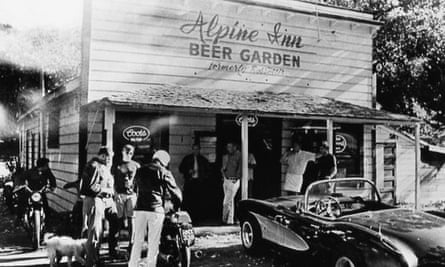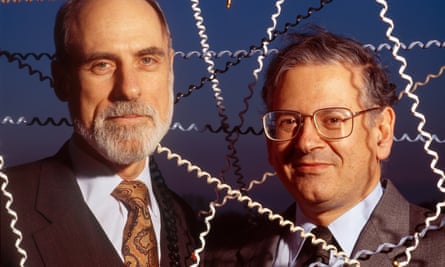In the kingdom of apps and unicorns, Rossotti’s is a rarity. This beer garden in the heart of Silicon Valley has been standing on the same spot since 1852. It isn’t disruptive; it doesn’t scale. But for more than 150 years, it has done one thing and done it well: it has given Californians a good place to get drunk.
During the course of its long existence, Rossotti’s has been a frontier saloon, a gold rush gambling den, and a Hells Angels hangout. These days it is called the Alpine Inn Beer Garden, and the clientele remains as motley as ever. On the patio out back, there are cyclists in spandex and bikers in leather. There is a wild-haired man who might be a professor or a lunatic or a CEO, scribbling into a notebook. In the parking lot is a Harley, a Maserati, and a horse.
It doesn’t seem a likely spot for a major act of innovation. But 40 years ago this August, a small team of scientists set up a computer terminal at one of its picnic tables and conducted an extraordinary experiment. Over plastic cups of beer, they proved that a strange idea called the internet could work.
The internet is so vast and formless that it’s hard to imagine it being invented. It’s easy to picture Thomas Edison inventing the lightbulb, because a lightbulb is easy to visualize. You can hold it in your hand and examine it from every angle.
The internet is the opposite. It’s everywhere, but we only see it in glimpses. The internet is like the holy ghost: it makes itself knowable to us by taking possession of the pixels on our screens to manifest sites and apps and email, but its essence is always elsewhere.
This feature of the internet makes it seem extremely complex. Surely something so ubiquitous yet invisible must require deep technical sophistication to understand. But it doesn’t. The internet is fundamentally simple. And that simplicity is the key to its success.
The people who invented the internet came from all over the world. They worked at places as varied as the French government-sponsored computer network Cyclades, England’s National Physical Laboratory, the University of Hawaii and Xerox. But the mothership was the US defense department’s lavishly funded research arm, the Advanced Research Projects Agency (Arpa) – which later changed its name to the Defense Advanced Research Projects Agency (Darpa) – and its many contractors. Without Arpa, the internet wouldn’t exist.

As a military venture, Arpa had a specifically military motivation for creating the internet: it offered a way to bring computing to the front lines. In 1969, Arpa had built a computer network called Arpanet, which linked mainframes at universities, government agencies, and defense contractors around the country. Arpanet grew fast, and included nearly 60 nodes by the mid-1970s.
But Arpanet had a problem: it wasn’t mobile. The computers on Arpanet were gigantic by today’s standards, and they communicated over fixed links. That might work for researchers, who could sit at a terminal in Cambridge or Menlo Park – but it did little for soldiers deployed deep in enemy territory. For Arpanet to be useful to forces in the field, it had to be accessible anywhere in the world.
Picture a jeep in the jungles of Zaire, or a B-52 miles above North Vietnam. Then imagine these as nodes in a wireless network linked to another network of powerful computers thousands of miles away. This is the dream of a networked military using computing power to defeat the Soviet Union and its allies. This is the dream that produced the internet.
Making this dream a reality required doing two things. The first was building a wireless network that could relay packets of data among the widely dispersed cogs of the US military machine by radio or satellite. The second was connecting those wireless networks to the wired network of Arpanet, so that multimillion-dollar mainframes could serve soldiers in combat. “Internetworking,” the scientists called it.
Internetworking is the problem the internet was invented to solve. It presented enormous challenges. Getting computers to talk to one another – networking – had been hard enough. But getting networks to talk to one another – internetworking – posed a whole new set of difficulties, because the networks spoke alien and incompatible dialects. Trying to move data from one to another was like writing a letter in Mandarin to someone who only knows Hungarian and hoping to be understood. It didn’t work.
In response, the architects of the internet developed a kind of digital Esperanto: a common language that enabled data to travel across any network. In 1974, two Arpa researchers named Robert Kahn and Vint Cerf published an early blueprint. Drawing on conversations happening throughout the international networking community, they sketched a design for “a simple but very flexible protocol”: a universal set of rules for how computers should communicate.
These rules had to strike a very delicate balance. On the one hand, they needed to be strict enough to ensure the reliable transmission of data. On the other, they needed to be loose enough to accommodate all of the different ways that data might be transmitted.

“It had to be future-proof,” Cerf tells me. You couldn’t write the protocol for one point in time, because it would soon become obsolete. The military would keep innovating. They would keep building new networks and new technologies. The protocol had to keep pace: it had to work across “an arbitrarily large number of distinct and potentially non-interoperable packet switched networks,” Cerf says – including ones that hadn’t been invented yet. This feature would make the system not only future-proof, but potentially infinite. If the rules were robust enough, the “ensemble of networks” could grow indefinitely, assimilating any and all digital forms into its sprawling multithreaded mesh.
Eventually, these rules became the lingua franca of the internet. But first, they needed to be implemented and tweaked and tested – over and over and over again. There was nothing inevitable about the internet getting built. It seemed like a ludicrous idea to many, even among those who were building it. The scale, the ambition – the internet was a skyscraper and nobody had ever seen anything more than a few stories tall. Even with a firehose of cold war military cash behind it, the internet looked like a long shot.
Then, in the summer of 1976, it started working.
If you had walked into Rossotti’s beer garden on 27 August 1976, you would have seen the following: seven men and one woman at a table, hovering around a computer terminal, the woman typing. A pair of cables ran from the terminal to the parking lot, disappearing into a big grey van.
Inside the van were machines that transformed the words being typed on the terminal into packets of data. An antenna on the van’s roof then transmitted these packets as radio signals. These signals radiated through the air to a repeater on a nearby mountain top, where they were amplified and rebroadcast. With this extra boost, they could make it all the way to Menlo Park, where an antenna at an office building received them.
It was here that the real magic began. Inside the office building, the incoming packets passed seamlessly from one network to another: from the packet radio network to Arpanet. To make this jump, the packets had to undergo a subtle metamorphosis. They had to change their form without changing their content. Think about water: it can be vapor, liquid or ice, but its chemical composition remains the same. This miraculous flexibility is a feature of the natural universe – which is lucky, because life depends on it.

The flexibility that the internet depends on, by contrast, had to be engineered. And on that day in August, it enabled packets that had only existed as radio signals in a wireless network to become electrical signals in the wired network of Arpanet. Remarkably, this transformation preserved the data perfectly. The packets remained completely intact.
So intact, in fact, that they could travel another 3,000 miles to a computer in Boston and be reassembled into exactly the same message that was typed into the terminal at Rossotti’s. Powering this internetwork odyssey was the new protocol cooked up by Kahn and Cerf. Two networks had become one. The internet worked.
“There weren’t balloons or anything like that,” Don Nielson tells me. Now in his 80s, Nielson led the experiment at Rossotti’s on behalf of the Stanford Research Institute (SRI), a major Arpa contractor. Tall and soft-spoken, he is relentlessly modest; seldom has someone had a better excuse for bragging and less of a desire to indulge in it. We are sitting in the living room of his Palo Alto home, four miles from Google, nine from Facebook, and at no point does he even partly take credit for creating the technology that made these extravagantly profitable corporations possible.
The internet was a group effort, Nielson insists. SRI was only one of many organizations working on it. Perhaps that’s why they didn’t feel comfortable popping bottles of champagne at Rossotti’s – by claiming too much glory for one team, it would’ve violated the collaborative spirit of the international networking community. Or maybe they just didn’t have the time. Dave Retz, one of the researchers at Rossotti’s, says they were too worried about getting the experiment to work – and then when it did, too worried about whatever came next. There was always more to accomplish: as soon as they’d stitched two networks together, they started working on three – which they achieved a little over a year later, in November 1977.
Over time, the memory of Rossotti’s receded. Nielson himself had forgotten about it until a reporter reminded him 20 years later. “I was sitting in my office one day,” he recalls, when the phone rang. The reporter on the other end had heard about the experiment at Rossotti’s, and wanted to know what it had to do with the birth of the internet. By 1996, Americans were having cybersex in AOL chatrooms and building hideous, seizure-inducing homepages on GeoCities. The internet had outgrown its military roots and gone mainstream, and people were becoming curious about its origins. So Nielson dug out a few old reports from his files, and started reflecting on how the internet began. “This thing is turning out to be a big deal,” he remembers thinking.
What made the internet a big deal is the feature Nielson’s team demonstrated that summer day at Rossotti’s: its flexibility. Forty years ago, the internet teleported thousands of words from the Bay Area to Boston over channels as dissimilar as radio waves and copper telephone lines. Today it bridges far greater distances, over an even wider variety of media. It ferries data among billions of devices, conveying our tweets and Tinder swipes across multiple networks in milliseconds.

This isn’t just a technical accomplishment – it’s a design decision. The most important thing to understand about the origins of the internet, Nielson says, is that it came out of the military. While Arpa had wide latitude, it still had to choose its projects with an eye toward developing technologies that might someday be useful for winning wars. The engineers who built the internet understood that, and tailored it accordingly.
That’s why they designed the internet to run anywhere: because the US military is everywhere. It maintains nearly 800 bases in more than 70 countries around the world. It has hundreds of ships, thousands of warplanes, and tens of thousands of armored vehicles. The reason the internet can work across any device, network, and medium – the reason a smartphone in Sao Paulo can stream a song from a server in Singapore – is because it needed to be as ubiquitous as the American security apparatus that financed its construction.
The internet would end up being useful to the US military, if not quite in the ways its architects intended. But it didn’t really take off until it became civilianized and commercialized – a phenomenon that the Arpa researchers of the 1970s could never have anticipated. “Quite honestly, if anyone would have said they could have imagined the internet of today in those days, they’re lying,” says Nielson. What surprised him most was how “willing people were to spend money to put themselves on the internet”. “Everybody wanted to be there,” he says. “That was absolutely startling to me: the clamor of wanting to be present in this new world.”
The fact that we think of the internet as a world of its own, as a place we can be “in” or “on” – this too is the legacy of Don Nielson and his fellow scientists. By binding different networks together so seamlessly, they made the internet feel like a single space. Strictly speaking, this is an illusion. The internet is composed of many, many networks: when I go to Google’s website, my data must traverse 11 different routers before it arrives. But the internet is a master weaver: it conceals its stitches extremely well. We’re left with the sensation of a boundless, borderless digital universe – cyberspace, as we used to call it. Forty years ago, this universe first flickered into existence in the foothills outside of Palo Alto, and has been expanding ever since.

Comments (…)
Sign in or create your Guardian account to join the discussion